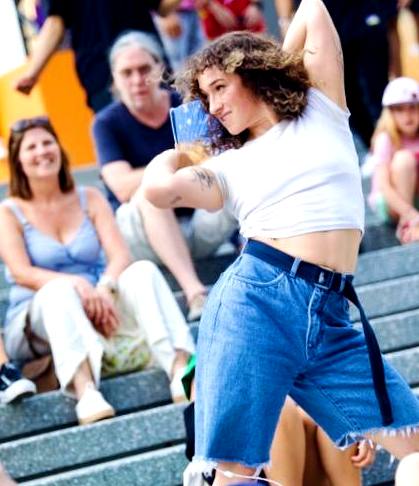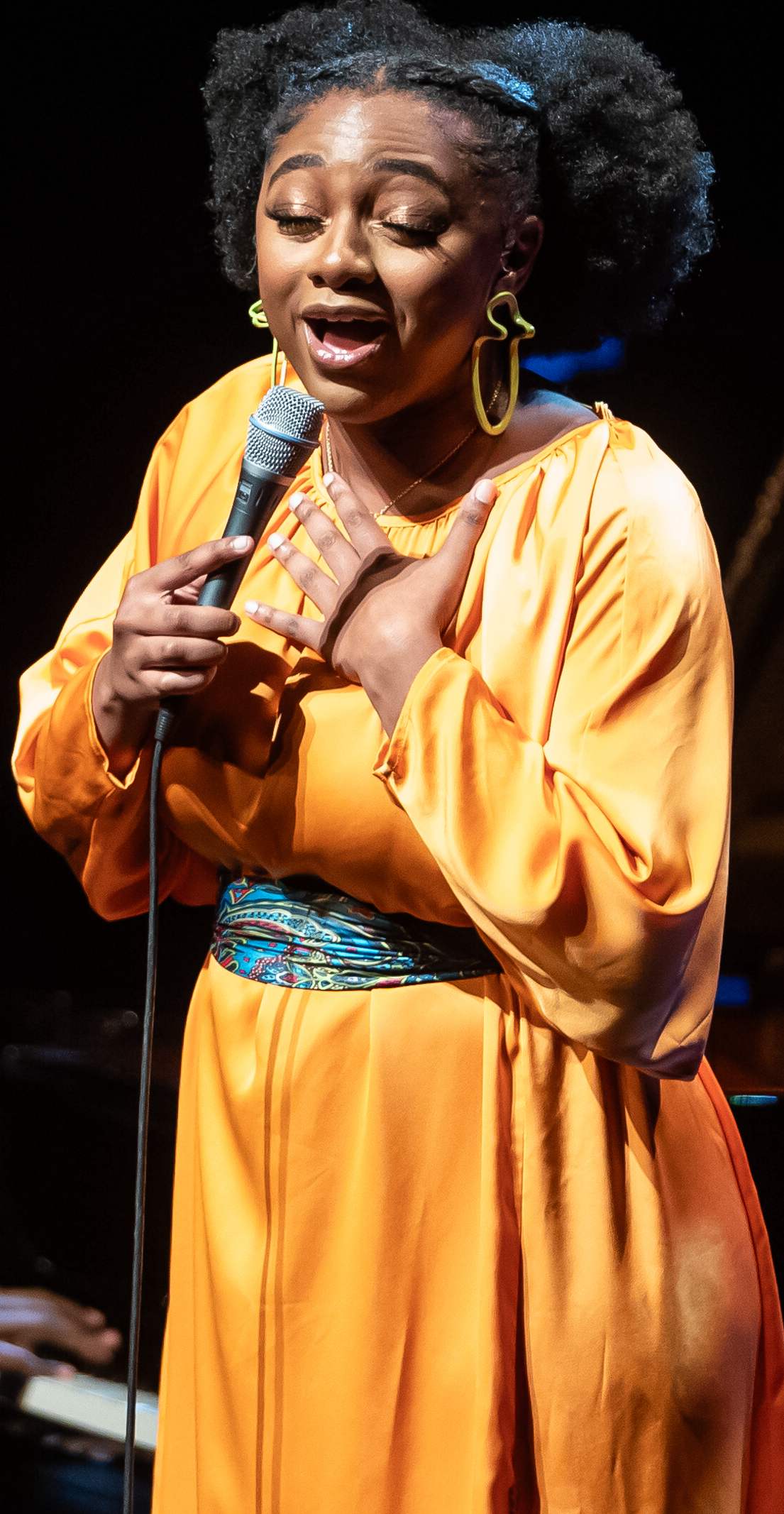Montreal's
internationally renown jazz
festival,
now in its 43rd year, offered a new face in terms of
strategic planning and programming. As one might expect, there
were some huge pluses and the cumulative effects of a few
negative developments. In respect to the all-important content
and ticketing categories, since change is the one constant
in life that doesn’t change, one has to pick and choose
according to availability. Fortunately, there was a huge plate
to choose from: there were over 300 indoor and outdoor concerts,
85% of which were sold out, which speaks to the post-Covid
hunger for music and an extended "living is easy"
interval. By all accounts, the jazzfest provided in dividends.
Among the
constants of the festival and arguably one of its main draws
is its carnival atmosphere. Taking place in a cordoned off
area the size of two square city blocks (Quartier des spectacles),
the festival is much more than the sum of  concerts
that run from noon to well past the midnight hour. It includes
outdoor dance virtuosos, live request-radio broadcasts, lots
of play areas and activities for children, an array of fountains
and sprays as a firewall against the heat and humidity, inter-active
music posts including a walk-on-me keyboard, ping pong tables,
circus acts, and lots of comfortable sitting areas, all of
which contribute to the high-fives and good vibes that are
synonymous with the festival.
concerts
that run from noon to well past the midnight hour. It includes
outdoor dance virtuosos, live request-radio broadcasts, lots
of play areas and activities for children, an array of fountains
and sprays as a firewall against the heat and humidity, inter-active
music posts including a walk-on-me keyboard, ping pong tables,
circus acts, and lots of comfortable sitting areas, all of
which contribute to the high-fives and good vibes that are
synonymous with the festival.
In a festival
of this size and scope, there is no circumventing the importance
of programming. After decades at the helm, festival programmer
Laurent Saulnier decided to call it day, passing the baton
– a terabyte of music waiting to be evaluated -- to
the younger and hipper Maurin Auxéméry who is
equally at home listening to hip-hop and/or  Mozart’s
Requiem. I first met the young-and-up-and-coming Maurin in
2010 where he was one of the guiding lights for the Jazz en
Rafale festival. Back then, I made a prediction
about his trajectory, and I’m happy to
report that my instincts served me well.
Mozart’s
Requiem. I first met the young-and-up-and-coming Maurin in
2010 where he was one of the guiding lights for the Jazz en
Rafale festival. Back then, I made a prediction
about his trajectory, and I’m happy to
report that my instincts served me well.
In terms
of content, the most noticeable change was in the outdoor
programming, arguably the best ever, at least since I've been
covering the festival. (2005). Despite Maurin's personal music
preferences (some of which had me looking for the nearest
vomitorium), he wanted to bring more jazz to the festival,
and if he fell somewhat short of his goal in respect to indoor
programming, there was more quality jazz than ever outside
that ranged from fusion to the more complex forms, meaning
there was jazz for every taste. In consideration of the intimidating
jazz learning curve, the programmers made sure that the curve
was as easy as an electric glide in blue. Maurin and team
grasp that one doesn't so much like or dislike jazz, just
as one doesn't like or dislike a foreign language, but rather
that jazz is a language that many do not understand, which
has nothing to do with liking it or not. As a language that
has to be learned before one can like it, the Montreal jazz
festival, like no other, creates the conditions to make that
learning experience possible, and for that stroke of brilliance,
a huge mention must go to now retired but still very present
co-founders Alain
Simard and Andre Menard.
Perhaps the most felt change was the decision to no longer
publish the bi-lingual Montreal Jazz Festival magazine, which
was almost encyclopedic in scope. The publication not only
provided a detailed history of the festival as both a musical
and cultural event, but included personal statements from
the directors along with the city fathers, and most importantly,
a precise and informed summary of every single concert (all
300 +). For visitors, the publication was invaluable and for
journalists, the descriptive writing was music the ear couldn't
refuse (i.e. a mother-lode for plagiarists).
Also of note
in a minor key, this year's edition ended on a Saturday instead
of Sunday, which translated into one less day of music, but
the festival, as usual, remains the quintessential introduction
to summer and the festival season.
 Among
the outdoor highlights, a tightly packed crowd was regaled
with the piano wizardry of James Francies and his trio. He
won the Downbeat Up and Coming Keyboardist prize
in 2022. Still in his 20s, he has absorbed a number of diverse
influences, Oscar Peterson among them, but he already a distinctive
style that combines short but memorable flourishes of notes,
often angry, only to suddenly morph into sequences that are
more contemplative, punctuated with extended melodic lines
that feature arresting thematic counterpoint. Sometimes his
notes poured out like liquid honey, at other times like chopped
salad. But whatever the concept that was being explored and
elaborated on, it note-perfectly served by bassist Burniss
Earl Traviss and drummer Jeremy Dutton. Francies isn't afraid
to venture into unknown territory and audiences are quick
to pick up on his love of adventure, all of which is predicated
on being blessed with an inventive mind and tantalizing technique.
And of course his original material sets him apart from competition.
No surprise to learn that he's a favorite of Pet Metheny and
that the genre’s very best are cozying up to him.
Among
the outdoor highlights, a tightly packed crowd was regaled
with the piano wizardry of James Francies and his trio. He
won the Downbeat Up and Coming Keyboardist prize
in 2022. Still in his 20s, he has absorbed a number of diverse
influences, Oscar Peterson among them, but he already a distinctive
style that combines short but memorable flourishes of notes,
often angry, only to suddenly morph into sequences that are
more contemplative, punctuated with extended melodic lines
that feature arresting thematic counterpoint. Sometimes his
notes poured out like liquid honey, at other times like chopped
salad. But whatever the concept that was being explored and
elaborated on, it note-perfectly served by bassist Burniss
Earl Traviss and drummer Jeremy Dutton. Francies isn't afraid
to venture into unknown territory and audiences are quick
to pick up on his love of adventure, all of which is predicated
on being blessed with an inventive mind and tantalizing technique.
And of course his original material sets him apart from competition.
No surprise to learn that he's a favorite of Pet Metheny and
that the genre’s very best are cozying up to him.
Now in his
early 70s, in an interview with Rick Beato, Sting confessed
that what is non-negotiable in the new music he listens to is that it has to surprise him. I'm sure every
jaded listener couldn't agree more. There is nothing more
exhilarating than discovering a new talent, a new vision,
a new approach to music, a new interval. I'll never forget
the first time I heard Tommy Emmanuel, and the late great
Michael Hedges. This time round, the surprise came in the
form of a 23 year old jazz singer Samara Joy. She's is already
being compared to Billie Holiday and Ella Fitzgerald. What
astounds the listener is the maturity she brings to her repertoire,
a maturity that is usually won over by going through and surviving
the hard knocks of life. Her gift is her sensitivity, being
open and receptive to a wide range of experiences and being
able to channel them into her art. Her vocal range is formidable;
she hits the highs and lows with ease and her already resonant
voice is only going to get better.
listens to is that it has to surprise him. I'm sure every
jaded listener couldn't agree more. There is nothing more
exhilarating than discovering a new talent, a new vision,
a new approach to music, a new interval. I'll never forget
the first time I heard Tommy Emmanuel, and the late great
Michael Hedges. This time round, the surprise came in the
form of a 23 year old jazz singer Samara Joy. She's is already
being compared to Billie Holiday and Ella Fitzgerald. What
astounds the listener is the maturity she brings to her repertoire,
a maturity that is usually won over by going through and surviving
the hard knocks of life. Her gift is her sensitivity, being
open and receptive to a wide range of experiences and being
able to channel them into her art. Her vocal range is formidable;
she hits the highs and lows with ease and her already resonant
voice is only going to get better.
At the age
of 19 she won the Sarah Vaughn International Jazz Vocal Competition
and for the 2023 Grammy Awards she won Best Jazz Vocal Album.
What separates
the great interpreters of the standards from everyone else
and the hundreds of versions that have been recorded is the
ability of the singer to make you belief that s/he means what
she sings. Joy makes you believe that the lyrics belong to
her, are her issue, born in the blood, sweat and tears that
are part and parcel of the price one pays in daring to forge
one’s destiny. If her present track continues –
and she is already in the fast lane -- she is going to be
a major force in jazz well before she turns 30. All of which
are reasons to hitch your wagon to her star that is already
as bright as the summer moon that booms over Montreal –
Canada’s city of lights, city of nights, and city of
festivals sans égal (without equal).
Montreal
Jazz Festival 2024 -- here's looking at you.